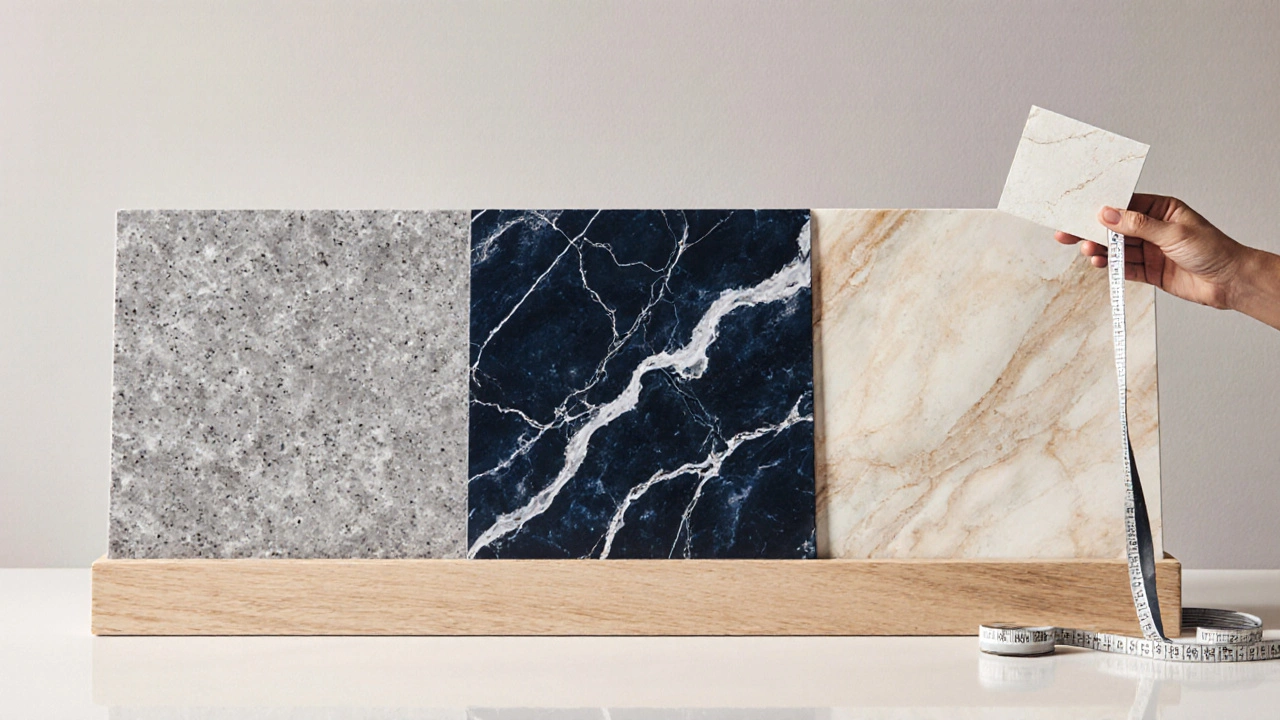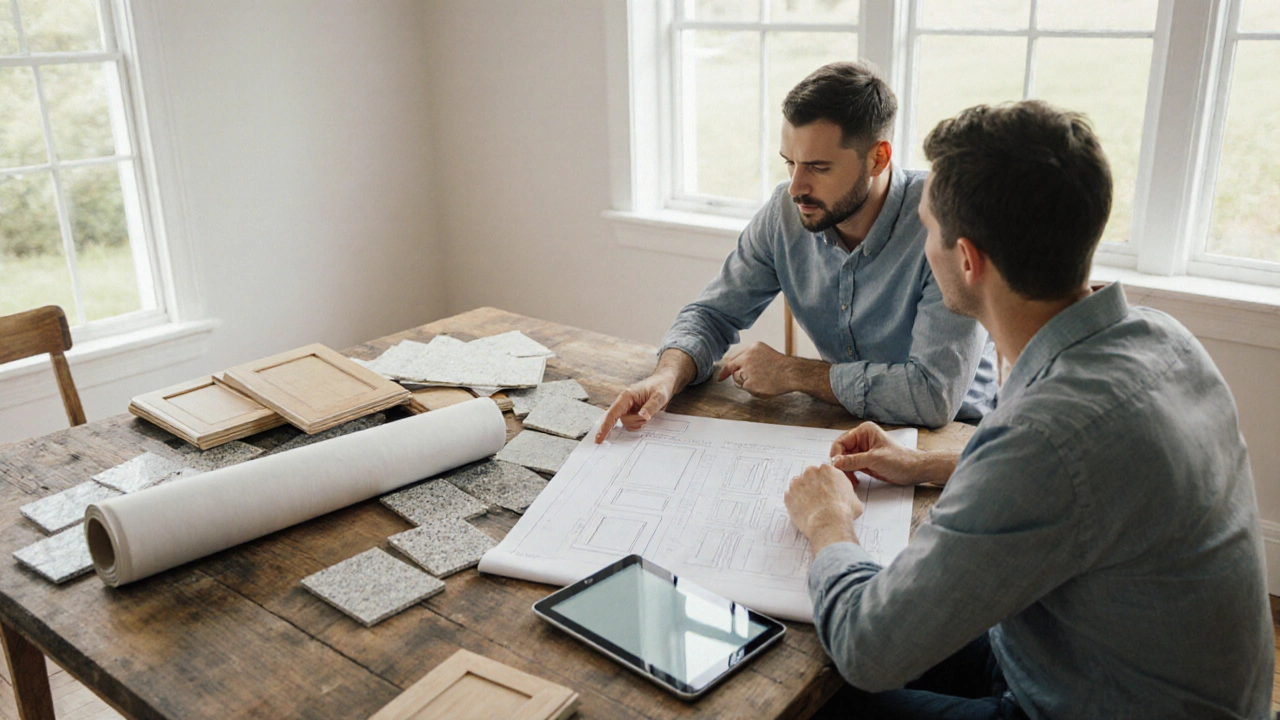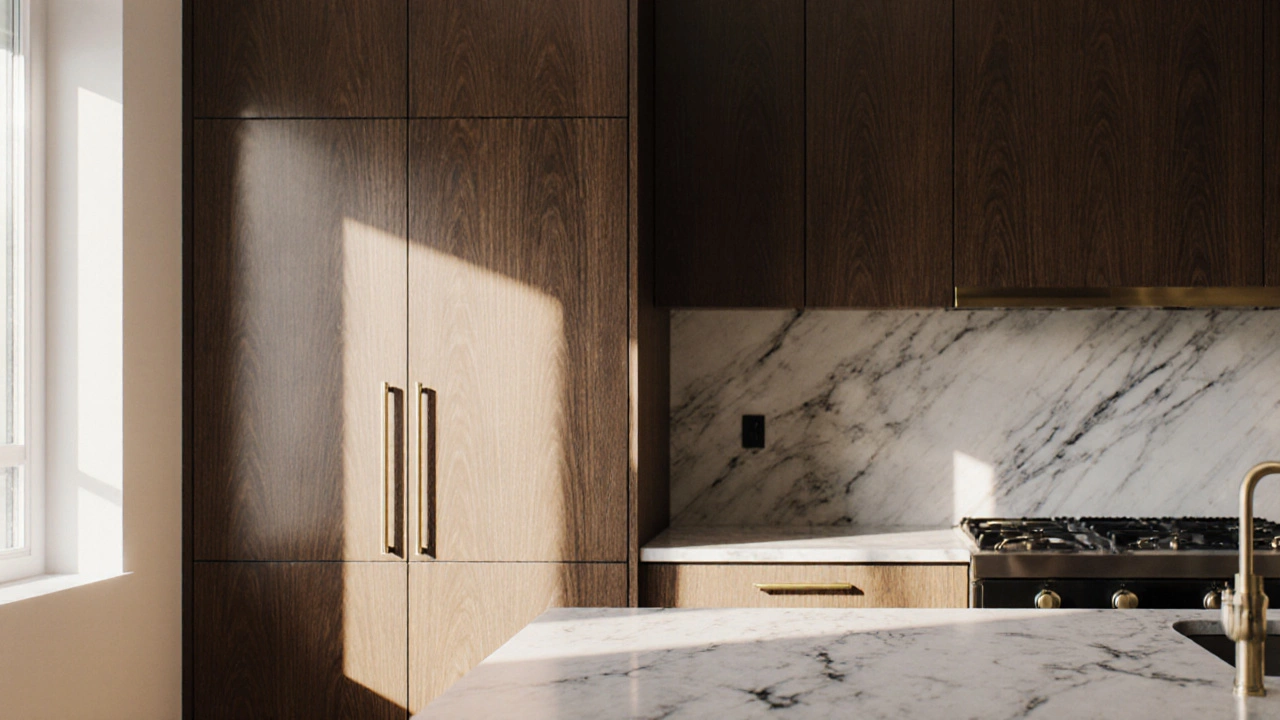Kitchen Remodel Cost Calculator
Budget Estimate
Budget Breakdown
Cabinets
Typical range: $9,000-$15,000 (USD) | $13,500-$22,500 (NZD)
Countertops
Typical range: $4,500-$8,000 (USD) | $6,750-$12,000 (NZD)
Appliances
Typical range: $3,000-$7,500 (USD) | $4,500-$11,250 (NZD)
Flooring
Typical range: $1,500-$3,000 (USD) | $2,250-$4,500 (NZD)
Plumbing & Electrical
Typical range: $1,500-$2,400 (USD) | $2,250-$3,600 (NZD)
Labor & Design
Typical range: $6,000-$12,000 (USD) | $9,000-$18,000 (NZD)
Tip: By choosing stock cabinets instead of custom, you can save 10-25% on your cabinet budget. Consider this when setting your priorities.
Quick Summary
- Cabinets typically claim 30‑35% of the total kitchen remodel cost, making them the single most expensive item.
- High‑end countertops (quartz, natural stone) are the next biggest expense, often 15‑20% of the budget.
- Appliances, flooring, and labor together can push the budget beyond the average $30,000‑$50,000 range.
- Smart budgeting tricks - choose ready‑made cabinets, opt for engineered stone, and plan labor in phases - can cut 10‑25% off the final bill.
- Understanding where the money goes helps you prioritize style over splurge.
Why Kitchen Costs Vary So Much
When a homeowner says, “I want a new kitchen,” the first question is often, “How much will it cost?” The answer depends on three core factors: materials - the quality of cabinets, countertops, flooring, etc.; the level of customization or luxury; and labor - the price of skilled trades and project management. Because each of these variables can span a wide price band, the overall budget can swing by tens of thousands of dollars.
Cabinets: The Biggest Money‑Sink
Cabinets are the backbone of any kitchen design, providing storage, defining layout, and setting the visual tone. According to the 2024 Kitchen Design Report, cabinets alone account for 30‑35% of the total remodel budget. A mid‑range custom cabinet system runs about $250‑$350 per linear foot, while high‑end solid‑wood or European‑style designs can exceed $600 per foot. For a 20‑foot layout, the price jumps from $5,000 to $12,000+.
Why are they so pricey? Custom fabrication, hardware (soft‑close hinges, high‑grade knobs), and finish work (sanded, stained, or painted) all add labor hours. Ready‑made stock cabinets drop the cost to $100‑$150 per linear foot but limit design flexibility. Homeowners who prioritize a cohesive, high‑quality look often end up spending the most on cabinets.
Countertops: The Close Runner‑Up
Countertops sit directly in front of the cabinets, making them a visual focal point. Popular choices include granite, quartz, marble, and engineered stone. Quartz, favored for its durability and low maintenance, averages $70‑$120 per square foot installed. Natural stone can climb to $150‑$200 per sqft when premium veining is involved.
For a standard 50‑sqft countertop area, the price ranges from $3,500 (budget laminate) to $10,000+ (high‑end marble). Since countertops make up roughly 15‑20% of total remodel spend, they’re the second‑most costly component after cabinets.

Appliances: The Technology Tag
Appliances - ranges, ovens, microwaves, and dishwashers - are the functional backbone of a kitchen. Budget models start around $300 per unit, while professional‑grade ranges can surpass $5,000 each. A typical mid‑range appliance package (cooktop, wall oven, fridge, dishwasher) costs $7,000‑$12,000.
Appliance costs represent roughly 10‑15% of the overall budget. The biggest price spikes come from smart‑connected features, dual‑fuel ranges, and built‑in coffee systems.
Flooring: Foundations Underfoot
Flooring sets durability and style. Engineered hardwood, luxury vinyl plank (LVP), and porcelain tile dominate modern kitchens. Engineered hardwood averages $8‑$12 per sqft installed, while high‑end porcelain tiles can hit $15‑$20 per sqft.
For a 150‑sqft kitchen floor, costs range from $1,200 (budget LVP) to $3,000+ (designer tile). Flooring typically consumes 5‑10% of the total remodel budget.
Plumbing & Electrical: The Hidden Helpers
Plumbing work includes moving sink lines, installing new faucets, and adding garbage disposals. Electrical upgrades cover new lighting, dedicated circuits for appliances, and smart home wiring.
Combined, these trades generally cost $2,000‑$5,000, representing 5‑8% of the overall spend. Unexpected code upgrades can add $1,000‑$2,000, so a contingency fund is wise.
Labor & Design Fees: The Project Glue
Even if you buy every material at a discount, you still need skilled hands to assemble the kitchen. Labor rates vary by region; in Auckland, a qualified carpenter charges around NZ$70‑$90 per hour, while a licensed electrician may bill NZ$80‑$110 per hour. Design consultants, whether they’re interior designers or kitchen specialists, usually charge 10‑15% of the total project cost.
Labor and design together can claim 20‑30% of the budget, making them the second biggest expense after cabinets when you factor in high‑priced labor markets.

How to Keep the Most Expensive Items in Check
- Shop stock cabinets and add custom doors or hardware for a tailored look without the full custom price.
- Choose engineered stone over natural marble to save 30‑40% while preserving durability.
- Bundle appliances from a single retailer; many offer package discounts of up to 15%.
- Plan the layout early to avoid costly plumbing re‑runs.
- Get multiple contractor bids and verify references; a 5‑10% price difference is common.
Typical Cost Breakdown (U.S. & NZ Averages)
| Component | Average % of Budget | Typical Cost (USD) | Typical Cost (NZD) |
|---|---|---|---|
| Cabinets | 30‑35% | $9,000‑$15,000 | $13,500‑$22,500 |
| Countertops | 15‑20% | $4,500‑$8,000 | $6,750‑$12,000 |
| Appliances | 10‑15% | $3,000‑$7,500 | $4,500‑$11,250 |
| Flooring | 5‑10% | $1,500‑$3,000 | $2,250‑$4,500 |
| Plumbing & Electrical | 5‑8% | $1,500‑$2,400 | $2,250‑$3,600 |
| Labor & Design | 20‑30% | $6,000‑$12,000 | $9,000‑$18,000 |
Common Pitfalls and How to Avoid Them
- Skipping the layout plan - leads to costly re‑routing of plumbing and electrical.
- Choosing the cheapest cabinets - may result in warping, higher long‑term replacement costs.
- Underestimating labor - trades often quote low estimates to win the job, then add change orders.
- Ignoring permits - unpermitted work can cause legal headaches and resale issues.
- Not budgeting for contingency - 10‑15% reserve protects against surprise material price spikes.
Next Steps for Your Kitchen Project
- Set a realistic total budget based on the breakdown above.
- Choose a style and decide where you can splurge (e.g., cabinets) vs. where you can save (e.g., flooring).
- Gather at least three quotes from reputable contractors; ask for a detailed cost line‑item list.
- Finalize material selections and place orders early to lock in prices.
- Schedule a project kickoff meeting, confirm timelines, and establish a communication plan.
Frequently Asked Questions
Which kitchen component typically costs the most?
Custom cabinets usually take the biggest slice of the budget, often 30‑35% of the total remodel cost.
Can I reduce cabinet costs without sacrificing quality?
Yes. Opt for semi‑custom or high‑quality stock cabinets and upgrade with premium doors, hardware, or finishes to keep the look while trimming the price.
How much should I set aside for unexpected expenses?
A contingency fund of 10‑15% of your total budget helps cover hidden costs like code upgrades or material price changes.
Are high‑end countertops worth the price?
If durability and resale value are top priorities, natural stone or premium quartz can pay off. For tighter budgets, engineered stone offers a good balance of look and cost.
Do I need a designer for a kitchen remodel?
A designer can optimize layout, ensure code compliance, and help you avoid costly mistakes. Their fee (usually 10‑15% of the project) often saves more than it costs.

Written by Fletcher Abernathy
View all posts by: Fletcher Abernathy